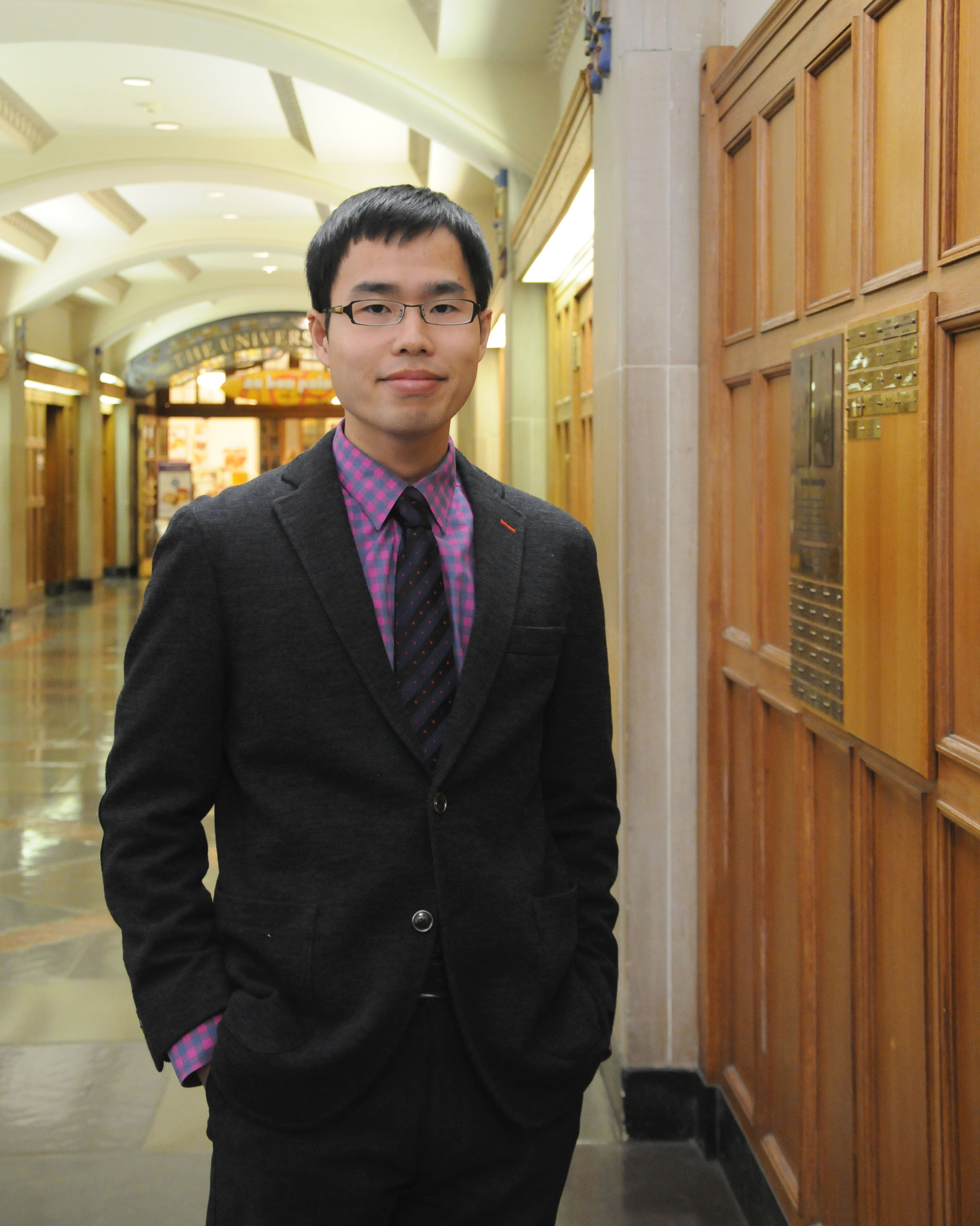Seminars 2014-2015
The Seminar Series begin at 12:30pm unless otherwise specified. Food will be served before the seminars. Financial support for the seminars was kindly provided by the Rackham Graduate School.

|
April 4, 2016 Optofluidic Lasers on Chip 12:30-1:30pm | 1180 DuderstadtDr. Sherman Fan Optofluidic lasers integrate microfluidics, gain medium in liquid environment, and microcavities. They hold great promise for miniaturized and reconfigurable coherent light sources on chip and unconventional biochemical detection and analysis. Here I will first introduce the principle of the optofluidic lasers and then review various types of designs of optofluidic lasers on chip, including ring resonator lasers, Fabry-Perot lasers, distributed-feedback lasers, and photonic crystal lasers, etc. Different types of gain media will be described, such as organic dyes, semiconductor quantum dots, enzyme-substrate reaction products, and fluorescent proteins, etc. Applications of the optofluidic laser will be discussed with emphasis on new optical functions that the optofluidic lasers can potentially offer.
|

|
March 7, 2016 Angiogenesis in liquid tumors: An in-vitro assay for leukemic cell induced bone marrow angiogenesis 12:30-1:30pm | 1121 LBMEDr. Yi Zheng The critical role of angiogenesis for solid tumor growth and metastatic spread has been well established. In contrast, even though increased vascularity has been commonly observed in bone marrows of patients with hematological malignancies (liquid tumors), the pathophysiology of leukemia induced angiogenesis in the bone marrow remains elusive. In this paper, we demonstrated the usage of a microengineered 3D biomimetic model to study leukemic cell induced bone marrow angiogenesis. Rational design of the 3D angiogenesis chip incorporating endothelial cells (ECs), leukemic cells, and bone marrow stromal fibroblasts provided an efficient biomimetic means to promote and visualize early angiogenic processes. Morphological features of angiogenesis induced by three different leukemic cell lines (U937, HL60, and K562) were investigated and compared. Quantitative measurements of angiogenic factors secreted from monocultures and cocultures of leukemic cells with bone marrow stromal fibroblasts suggested a synergistic relationship between ECs, leukemic cells, and bone marrow stromal fibroblasts for angiogenic induction, and also confirmed the necessity of conducting functional angiogenic assays in proper 3D biomimetic cell culture systems like the one developed in this work.
|

|
February 8, 2016 Worm Chips: Microfludics Toos for C. elegans Biology 12:30-1:30pm | 1180 DuderstadtDr. Nikos Chronis The study of small-size animal models, such as the roundworm C. elegans, has provided great insight into several in vivo biological processes, extending from cell apoptosis to neural network computing. The physical manipulation of this micron-sized worm has always been a challenging task. Here, we discuss the applications, capabilities and future directions of a new family of worm manipulation tools, the 'worm chips'. Worm chips are microfabricated devices capable of precisely manipulating single worms or a population of worms and their environment. Worm chips pose a paradigm shift in current methodologies as they are capable of handling live worms in an automated fashion, opening up a new direction in in vivo small-size organism studies.
|

|
January 25, 2016 Water in the Wiring: The Translation of Electronic Circuit Elements into the Fluidic Domain 12:30-1:30pm | 1180 DuderstadtPriyan Weerappuli Advancements in microfabrication have enabled the design of microfluidic systems supporting precise fluidic operations that would be impossible to perform manually. By exploiting fundamental similarities between the movement of fluids and that of charge, our lab has developed fluidic analogs for electronic circuit elements. These facilitate the translation of operations and protocols between the fluidic and electronic domains. This talk will focus upon two such elements – the transistor and capacitor – and the manner in which these elements may be combined to recapitulate and interrogate biochemical oscillations in vitro.
|

|
January 11th, 2016 Exploring Soft Micro-scale Bioassay Platforms Using Liquid-Liquid Interfaces 12:30-1:30pm | 1180 DuderstadtDr. Taisuke Kojima Takayama Lab | University of Michigan The scale of reactions determines the amount of products and the cost of materials and processes.
Consequently, it is important to determine the reaction scale based on the specific needs of the
user. The micro-scale reactor (microreactor), especially when performing multi-step reactions,
requires only a small quantity of sample and short time of reaction assessment and has great
advantages over the larger counterparts for reactions where materials are limited. As such, the
microreactor platform is particularly appealing to the pharmaceutical and biomedical industries
where the reduction in time and cost for fast evaluation and implementation of new production
protocols is critical. Liquid-liquid interfaces, as described herein, enable rapid and selective mass
exchange and diffusion with small quantity of reagents, provide robust and reliable reaction
platforms, and open new doors to explore functional material processes and biological assays
that conventional approaches requiring multiple reaction vessels fail to achieve. In this talk, soft
microreactors are explored and implemented in order to create novel micro-scale bioassay
platforms at liquid-liquid interfaces. First, a hybrid system of an aqueous two-phase system and
complex coacervation enabling robust membrane-free multi-compartmentalization was invented
and complex bioreactions were demonstrated. Next, a liquid-liquid micropatterning technique
was expanded to a gel-in-gel micropatterning technique for the biological application where
autonomous chemogradients formation and resulting cancer cell migration were performed. The
described micro-scale platforms at the liquid-liquid interfaces utilizing macromolecules and
microfabrication technology represent an advance in the microreactor concept and provide a
unique opportunity to explore further biomedical applications.
|

|
November 30, 2015 Engineering Microsystems to Investigate Hematologic Processes and Disorders Towards Clinical Translation 12:30-1:30pm | 1180 DuderstadtDr. Wilbur A. Lam Hematologic processes are frequently comprised of cellular and biomolecular interactions that are biophysical in nature and may involve blood cells (erythrocytes, leukocytes, and platelets), endothelial cells, soluble factors (coagulation proteins, von Willebrand factor, and cytokines), the hemodynamic environment, or all of the above. These phenomena are often pathologically altered in hematologic and thrombotic diseases and are difficult to study using standard in vitro and in vivo systems. With the capabilities to dissect cellular and biomolecular phenomena at the micro to nanoscales with tight control of the mechanical and fluidic parameters, micromechanical and microfluidic systems may provide new insight into key aspects of hematology. For example, the capability of using microsystems to study biology at the single cell level enables the quantitative investigation of how the mechanical and physical microenvironment affects platelet physiology and biophysics. Using micromechanical systems, we have characterized platelet contraction, a poorly understood biophysical aspect of clotting, at the single cell level and have demonstrated that platelet contraction force is not only dependent on microenvironmental mechanical and biochemical cues but may also function as a clinical biophysical biomarker to aid in the diagnosis of bleeding disorders. In addition, using single cell micropatterning techniques to study single platelets, we have demonstrated that platelets sense and physiologically respond to the geometry and physical properties of their microenvironment. Microfluidic systems also enable the quantitative study of hematologic and vascular phenomena under tightly controlled hemodynamic conditions. Using microfluidic techniques, we have developed “endothelialized” microvasculature models to probe the cellular mechanical mechanisms of sickle cell disease and thrombotic microangiopathies and to function as novel hemostasis assays. Finally, microfluidic experiments may lead to reductionist insights that could not be achieved with in vivo animal models alone. For instance, our lab has recently leveraged a microfluidic approach to deduce the multifaceted underlying mechanisms of the in vivo ferric chloride thrombosis model. By developing state-of-the art microdevices to answer hematologic questions, microsystems engineering has the potential to significantly advance our understanding of blood disorders and to develop novel diagnostics and therapeutic targets for patients afflicted with those potentially life-threatening diseases.
|

|
November 9th, 2015 Characterization of Nanoparticle Aggregation in Biologically Relevant Fluids 12:30-1:30pm | 1180 DuderstadtDr. Kathleen McEnnis Lahann Group | University of Michigan Nanoparticles are often studied as potential drug delivery carriers, but further understanding of their behavior in the body is necessary prior to successful application. The surface chemistry of a nanoparticle is critical to its aggregation behavior. For targeted drug delivery applications, ligands on nanoparticles are often modified for specific targeting purposes with little known about how the ligands will affect the aggregation of the nanoparticles. In the case of targeted drug delivery carriers, nanoparticles that are injected into the blood stream must successfully circulate for a sufficient duration to find their intended targets. To simulate this particle circulation, researchers typically use animal models such as mice. In these experiments nanoparticles are often shunted to the liver and spleen by the immune system shortly after injection, and following this immune modulation, it is difficult to gain any meaningful knowledge. The use of animals for these experiments is costly and also raises ethical questions. As an alternative, a method of analyzing nanoparticles in biologically relevant fluids such as blood plasma has been developed using nanoparticle tracking analysis (NTA) with fluorescent filters. NTA tracks particles individually, and this particle-by-particle approach makes NTA an accurate method of determining particle concentration and size distribution, even in complex fluids such as blood plasma. Typically dynamic light scattering (DLS) is used to analyze particle size and thus aggregation behavior, but DLS cannot be used in this case because the components of blood scatter light as well. Using NTA with fluorescent filters, the aggregation behavior of the nanoparticles can be observed and quantified and specific ligand formulations can be tested for aggregation behavior in blood plasma before proceeding to in vivo studies.
In this work, NTA was used to analyze the aggregation behavior of fluorescently labeled PS nanoparticles in blood plasma. The effect of surface chemistry on aggregation behavior was investigated by quantifying percentage of particles in aggregates at a given time point after adding to blood plasma. PS nanoparticles with various surface modifications, such as carboxylate, amine, and sulfate, were tested in blood plasma at 37°C over a time period of two days, and the percentage of aggregation was quantified. The use of this characterization method will allow for better understanding of particle behavior once nanoparticles are injected into an animal, and potential problems, specifically aggregation, can be dealt with at this stage before investing heavily in in vivo studies.
|

|
October 26th, 2015 A novel, on-chip immunobiosensing platform for rapidly quantifying multiple cellular signaling biomolecules in physiological samples 12:30-1:30pm | 1180 DuderstadtYujing Song University of Michigan Recent therapeutics development leads to an urgent need of rapid, accurate biosensing platforms that can identify ultra-low concentrations of biomolecules for human immune status monitoring and early disease detection. With the benefits of sensor miniaturization, multiplexing capacity, low sample volume, and high sensitivity and throughput, LSPR-based (Localized surface plasmon resonance) biosensing platforms are considered to be the next generation of plasmonic sensing systems which show great promise to meet clinical needs. In this talk, a novel label-free LSPR-based nanoplasmonic microfluidic biosensing platform developed in Dr. Kurabayashi's lab will be reviewed. Specifically, our new generation of LSPR biosensor coupled with an electrokinetic micromixer to reach sub-femtomolar detection in diffusion-limit binding (biotin-streptavidin) will be discussed in detail. Numerical and Experimental results have shown that our new generation of LSPR biosensor can significantly shorten the assay time, reduce the sample volume and effectively eliminate non-specific binding by the self-washing process induced by AC electro-osmosis flow
|

|
October 12th, 2015 Extracellular matrix remodeling in obesity and diabetes 12:30-1:30pm | 2150 DOWDr. Tae-Hwa Chun Assistant Professor of Internal Medicine and Member of the Biointerfaces Institute University of Michigan Extracellular matrix (ECM) remodeling is a key physiological process that regulates adipose tissue function. Our findings suggest that excess calorie intake leads to dysregulated ECM remodeling and adipose tissue dysfunction. Thrombospondin-1 (THBS1) is a visceral fat-derived ECM that circulates and causes muscle insulin resistance and fibrosis. We hypothesize that the pathological crosstalk between adipose tissues and skeletal muscles should underlie the disease link between obesity and diabetes. I would like to discuss genetically modified mouse models we use for the study of obesity and diabetes and the ongoing collaboration with Dr. Shuichi Takayama’s lab (Biomedical Engineering) to develop human metabolic organs on-a-chip.
|

|
September 28th, 2015 Band-pass processing in a GPCR-mediated pathway: delineating signaling architecture using microfluidics and computational modeling 12:30-1:30pm | 2150 DOWMadhuresh Sumit, University of Michigan Biological processes are influenced by the timing of critical signals. Using a microfluidic delivery system with real-time assessment of cellular calcium and Ca2+-regulated transcription factor NFAT, we evaluate how the timing of extracellular ligand pulses affects cell signaling events. We find that lesser amounts of ligand stimulation can give more efficient NFAT activation when stimuli are timed appropriately. Mechanistically, the receptor and NFAT transcription factor motifs form a band-pass filter optimized for intermediate frequencies of stimulation. Distinct optima are found for two closely related NFAT isoforms. Computational modeling suggests that the band-pass nature of signaling pathways may be a generic theme. These findings may facilitate the design of therapeutic interventions and the development of enhanced in vitro cell culture protocols.
|

|
September 14, 2015 A Flexible Micro Spring Array Device for Rapid Enrichment of Viable Circulating Tumor Cells 12:30-1:30pm | 1180 DuderstadtRamdane Harouaka, Reserach Fellow, University of Michigan The process of cancer metastasis by which malignant cells detach from a primary tumor, spread through the circulatory system, then invade and colonize distant organs is responsible for more than 90% of cancer related deaths. When migratory cancer cells are present in the peripheral blood circulation they are called circulating tumor cells (CTCs). CTCs may be obtained from blood samples in a minimally invasive way as a surrogate for active disease. The enumeration of CTCs has been established as a prognostic biomarker for prediction of survival outcomes in breast, prostate and colon cancer. However, widespread application of CTC analysis to the clinic has been hindered by their extreme rarity, with each CTC being obscured by a background of billions of healthy blood cells. We have developed a flexible micro spring array (FMSA) device for antigen-independent physical enrichment of CTCs based on cell size and deformability. Flexible spring structures were fabricated from parylene polymer and applied to minimize cell disturbance at the micro scale, while maximizing throughput to allow rapid enrichment directly from unprocessed whole blood. Device performance with respect to capture efficiency, enrichment against leukocytes, viability and proliferability was characterized through reconstructed model systems using cancer cell lines. CTCs and circulating microclusters were successfully enriched from clinical samples obtained from breast, lung and colorectal cancer patients and characterized through immunocytochemical analysis.
|
